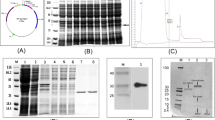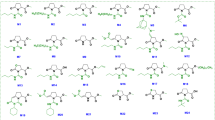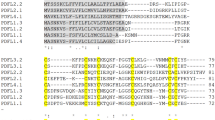Abstract
Defensins are small cysteine-rich peptides with antimicrobial activity. We demonstrate that the alfalfa antifungal peptide (alfAFP) defensin isolated from seeds of Medicago sativa displays strong activity against the agronomically important fungal pathogen Verticillium dahliae. Expression of the alfAFP peptide in transgenic potato plants provides robust resistance in the greenhouse. Importantly, this resistance is maintained under field conditions. There have been no previous demonstrations of a single transgene imparting a disease resistance phenotype that is at least equivalent to those achieved through current practices using fumigants.
This is a preview of subscription content, access via your institution
Access options
Subscribe to this journal
Receive 12 print issues and online access
$209.00 per year
only $17.42 per issue
Buy this article
- Purchase on Springer Link
- Instant access to full article PDF
Prices may be subject to local taxes which are calculated during checkout






Similar content being viewed by others
References
James, W.C., Teng, P.S. & Nutter, F.W. In CRC Handbook of pest management in agriculture , Edn. 2 (ed. Pimentel, D.) 15–50 (CRC Press, Ithaca, NY; 1990).
Estruch, J.J. et al. Transgenic plants: an emerging approach to pest control. Nat. Biotechnol. 15, 137–141 (1997).
Shah, D.M. Genetic engineering for fungal and bacterial diseases. Curr. Opin. Biotechnol . 8, 208–214 (1997).
Jach, G. et al. Enhanced quantitative resistance against fungal disease by combinatorial expression of different barley antifungal proteins in transgenic tobacco. Plant J. 8, 97–109 ( 1995).
Lorito, M. et al. Genes from mycoparasitic fungi as a source for improving plant resistance to fungal pathogens. Proc. Natl. Acad. Sci. U. S. A. 95, 7860–5. (1998).
Epple, P., Apel, K. & Bohlmann, H. Overexpression of an endogenous thionin enhances resistance of Arabidopsis against Fusarium oxysporum. Plant Cell 9, 509–520 ( 1997).
Hain, R. et al. Disease resistance results from foreign phytoalexin expression in a novel plant. Nature 361, 153– 156 (1993).
Broekaert, W.F. et al. Antimicrobial peptides from plants. Crit. Rev. Plant Sci. 16, 297–323 ( 1997).
Thevissen, K., Terras, F.R. & Broekaert, W.F. Permeabilization of fungal membranes by plant defensins inhibits fungal growth. Appl. Environ. Microbiol. 65 , 5451–5458 (1999).
Barry, G. et al. Commercialization of glyphosate herbicide resistant crops for improved weed control. J. Cell. Biochem. 16 (Suppl. F), 202 (1992).
McRae, K.B. & Platt, H.W. An index for cultivar resistance based on disease progress curves. Phytopathology 77, 1181–1186 (1987).
Kaniewski, W. K. & Thomas, P.E. Field testing for virus resistance and agronomic performance in transgenic plants. Mol. Biotechnol. 12, 101–115 (1999).
Information system for biotechnology. http://www.nbiap.vt.edu
Garcia-Olmedo, F., Molina, A., Alamillo, J.M. & Rodriguez-Palenzuela, P. Plant defense peptides. Biopolymers 47, 479–491 (1998).
Cornelissen B.J.C. et al. Fungal resistant plants, process for obtaining fungal resistant plants and recombinant polynucleotides for use therein. US 5,670,706 (1997).
Liang, J., Shah, D.M., Wu, Y.S., Rosenberger, C.A. & Hakimi, S. Antifungal polypeptide(s) and methods for controlling plant pathogenic fungi. US 06121436 ( 2000).
Sambrook, J., Fritsch, E. & Maniatis, T. Molecular cloning: a laboratory manual. (Cold Spring Harbor Laboratory, Cold Spring Harbor, NY; 1989).
Hudyncia, J., Shew, H.D., Cody, B.R. & Cubeta, M.A. Evaluation of wounds as a factor to infection of cabbage by ascospores of Sclerotinia sclerotiorum. Plant Dis. 84, 316– 320 (2000).
Long, D.H. Effect of nitrogen on disease progress of rice blast on susceptible and resistant cultivars. Plant Dis. 84, 403– 409 (2000).
Anderson, N.A. & Hoyos, G.P. Evaluation of potato germplasm for Verticillium wilt resistance. Am. Potato J. 65, 469 (1988).
Acknowledgements
The authors wish to thank Doug Rouse (University of Wisconsin), Mary Powelson (Oregon State University), Jiamin Zeng, Kairong Tiang, Kim Rayford, Judy Heinz, Jerry Anderson, Karen Fitzsimmons, Bonnie Hsiang, Glenda DeBrecht, Tom Salaiz, Jim Zalewski, Stephanie Prinsen, and Marjorie A. Manning for their participation in various aspects of this work.
Author information
Authors and Affiliations
Corresponding author
Rights and permissions
About this article
Cite this article
Gao, AG., Hakimi, S., Mittanck, C. et al. Fungal pathogen protection in potato by expression of a plant defensin peptide. Nat Biotechnol 18, 1307–1310 (2000). https://doi.org/10.1038/82436
Received:
Accepted:
Issue Date:
DOI: https://doi.org/10.1038/82436
This article is cited by
-
Efficiency of the alpha-hairpinin SmAMP-X gene promoter from Stellaria media plant depends on selection of transgenic approach
Transgenic Research (2024)
-
Shining in the dark: the big world of small peptides in plants
aBIOTECH (2023)
-
Chickpea Defensin Gene Family: Promising Candidates for Resistance Against Soil-Borne Chickpea Fungal Pathogens
Journal of Plant Growth Regulation (2023)
-
Further Characterization of MUAS35SCP and FUAS35SCP Recombinant Promoters and Their Implication in Translational Research
Molecular Biotechnology (2022)
-
Plant antimicrobial peptides: structures, functions, and applications
Botanical Studies (2021)



